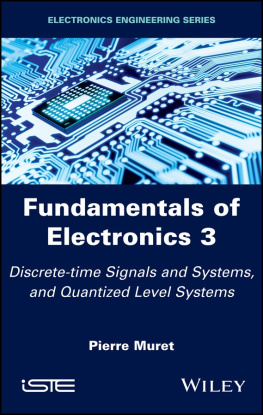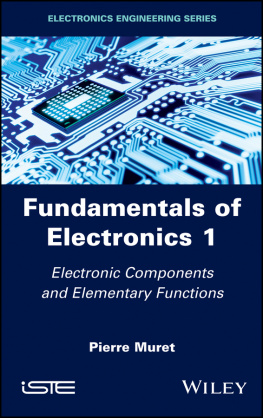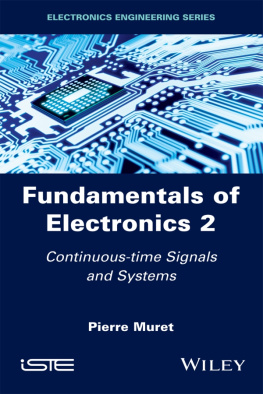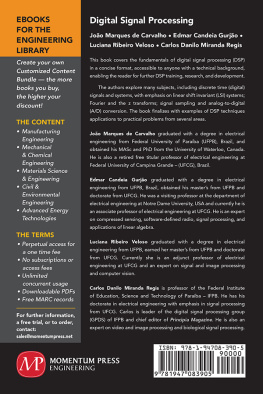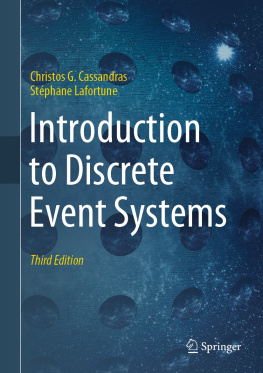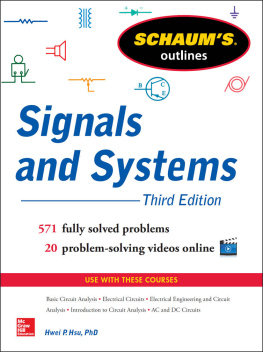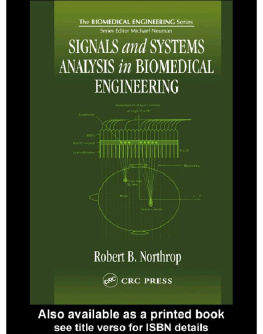Pierre Muret - Fundamentals of Electronics 3: Discrete-time Signals and Systems, and Quantized Level Systems
Here you can read online Pierre Muret - Fundamentals of Electronics 3: Discrete-time Signals and Systems, and Quantized Level Systems full text of the book (entire story) in english for free. Download pdf and epub, get meaning, cover and reviews about this ebook. year: 2018, publisher: Wiley-ISTE, genre: Science. Description of the work, (preface) as well as reviews are available. Best literature library LitArk.com created for fans of good reading and offers a wide selection of genres:
Romance novel
Science fiction
Adventure
Detective
Science
History
Home and family
Prose
Art
Politics
Computer
Non-fiction
Religion
Business
Children
Humor
Choose a favorite category and find really read worthwhile books. Enjoy immersion in the world of imagination, feel the emotions of the characters or learn something new for yourself, make an fascinating discovery.
- Book:Fundamentals of Electronics 3: Discrete-time Signals and Systems, and Quantized Level Systems
- Author:
- Publisher:Wiley-ISTE
- Genre:
- Year:2018
- Rating:5 / 5
- Favourites:Add to favourites
- Your mark:
- 100
- 1
- 2
- 3
- 4
- 5
Fundamentals of Electronics 3: Discrete-time Signals and Systems, and Quantized Level Systems: summary, description and annotation
We offer to read an annotation, description, summary or preface (depends on what the author of the book "Fundamentals of Electronics 3: Discrete-time Signals and Systems, and Quantized Level Systems" wrote himself). If you haven't found the necessary information about the book — write in the comments, we will try to find it.
Pierre Muret: author's other books
Who wrote Fundamentals of Electronics 3: Discrete-time Signals and Systems, and Quantized Level Systems? Find out the surname, the name of the author of the book and a list of all author's works by series.
Fundamentals of Electronics 3: Discrete-time Signals and Systems, and Quantized Level Systems — read online for free the complete book (whole text) full work
Below is the text of the book, divided by pages. System saving the place of the last page read, allows you to conveniently read the book "Fundamentals of Electronics 3: Discrete-time Signals and Systems, and Quantized Level Systems" online for free, without having to search again every time where you left off. Put a bookmark, and you can go to the page where you finished reading at any time.
Font size:
Interval:
Bookmark:

Pierre Muret

First published 2018 in Great Britain and the United States by ISTE Ltd and John Wiley & Sons, Inc.
Apart from any fair dealing for the purposes of research or private study, or criticism or review, as permitted under the Copyright, Designs and Patents Act 1988, this publication may only be reproduced, stored or transmitted, in any form or by any means, with the prior permission in writing of the publishers, or in the case of reprographic reproduction in accordance with the terms and licenses issued by the CLA. Enquiries concerning reproduction outside these terms should be sent to the publishers at the undermentioned address:
ISTE Ltd
27-37 St Georges Road
London SW19 4EU
UK
www.iste.co.uk
John Wiley & Sons, Inc.
111 River Street
Hoboken, NJ 07030
USA
www.wiley.com
ISTE Ltd 2018
The rights of Pierre Muret to be identified as the author of this work have been asserted by him in accordance with the Copyright, Designs and Patents Act 1988.
Library of Congress Control Number: 2018930834
British Library Cataloguing-in-Publication Data
A CIP record for this book is available from the British Library
ISBN 978-1-78630-183-3
Today, we can consider electronics to be a subject derived from the theoretical advances achieved during the 20th Century in areas comprising the modeling and conception of components, circuits, signals and systems, together with the tremendous development attained in integrated circuit technology. However, such development led to something of a knowledge diaspora that this work will attempt to contravene by collecting the general principles at the center of all electronic systems and components, together with the synthesis and analysis methods required to describe and understand these components and subcomponents. The work is divided into three volumes. Each volume follows one guiding principle from which various concepts flow. Accordingly, Volume 1 addresses the physics of semiconductor components and the consequences thereof, that is, the relations between component properties and electrical models. Volume 2 addresses continuous time systems, initially adopting a general approach in . The chapter headings are indicated in the following general outline.
Each chapter is paired with exercises and detailed corrections, with two objectives. First, these exercises help illustrate the general principles addressed in the course, proposing new application layouts and showing how theory can be implemented to assess their properties. Second, the exercises act as extensions of the course, illustrating circuits that may have been described briefly, but whose properties have not been studied in detail. The first volume should be accessible to students with a scientific literacy corresponding to the first 2 years of university education, allowing them to acquire the level of understanding required for the third year of their electronics degree. The level of comprehension required for the following two volumes is that of students on a masters degree program or enrolled in engineering school.
In summary, electronics, as presented in this book, is an engineering science that concerns the modeling of components and systems from their physical properties to their established function, allowing for the transformation of electrical signals and information processing. Here, the various items are summarized along with their properties to help readers follow the broader direction of their organization and thereby avoid fragmentation and overlap. The representation of signals is treated in a balanced manner, which means that the spectral aspect is given its proper place; to do otherwise would have been outmoded and against the grain of modern electronics, since now a wide range of problems are initially addressed according to criteria concerning frequency response, bandwidth and signal spectrum modification. This should by no means overshadow the application of electrokinetic laws, which remains a necessary first step since electronics remains fundamentally concerned with electric circuits. Concepts related to radio-frequency circuits are not given special treatment here, but can be found in several chapters. Since the summary of logical circuits involves digital electronics and industrial computing, the part treated here is limited to logical functions that may be useful in binary numbers computing and elementary sequencing. The author hopes that this work contributes to a broad foundation for the analysis, modeling and synthesis of most active and passive circuits in electronics, giving readers a good start to begin the development and simulation of integrated circuits.
- 1) Volume 1: Electronic Components and Elementary Functions [MUR 17a].
- i) Diodes and Applications
- ii) Bipolar Transistors and Applications
- iii) Field Effect Transistor and Applications
- iv) Amplifiers, Comparators and Other Analog Circuits
- 2) Volume 2: Continuous-time Signals and Systems [MUR 17b].
- i) Continuous-time Stationary Systems: General Properties, Feedback, Stability, Oscillators
- ii) Continuous-time Linear and Stationary Systems: Two-port Networks, Filtering and Analog Filter Synthesis
- 3) Volume 3: Discrete-time Signals and Systems, and Quantized Level Systems.
- i) Discrete-time Signals: Sampling, Filtering and Phase Control, Frequency control circuits
- ii) Quantized Level Systems: Digital-to-analog and Analog-to-digital Conversions
Pierre MURET
February 2018
This third volume covers signals and systems dealing with variables or quantities that are discrete or quantized. This leads to distinguishing two chapters: the first concerning the discrete-time case and the second that of discrete (or quantized) levels. The electronic circuits and applications implemented are of analog, digital or mixed nature, and some make use of both types of discretization. Similar to the previous volume, it is fundamental to explain the signals and their properties in detail as well as the basic circuits that transform these signals before considering the functions performed by more complex arrangements, which we will refer to as systems.
The first chapter begins with the study of discrete-time signals, obtained by sampling continuous-time signals, first by means of ideal sampling, then by actual sampling or by using interpolation. The use of the Fourier transform is essential and allows us to demonstrate, on the one hand, equivalences between a discrete variable in one domain and the periodic nature of the quantity depending on the dual variable in the other domain and, on the other hand, the fundamental theorem which determines the possibility to preserve (or not) all the information contained within a signal when shifting from continuous-time to discrete-time domains, called the sampling theorem or the Shannon theorem. Basic analog circuits are described. The other transforms, relevant in cases where discretization can be applied in both time and frequency domains, are also indicated since these are the ones that are used in practice. Next follows the study of the measurement of the time delay and of the phase shift between periodic signals in circuits comprising basic analog and logic functions, which are now widely used. Since this measurement is only achieved once per period, the measured time and phase shifts become discrete quantities. However, in many cases, the approximation which consists of only considering the continuous-time domain, obtained by interpolation and assuming that stationarity is preserved, makes it possible to detail the operation of the analog phase-locked loop (PLL) and the correction strategies of this loop system. This approximation is also a means to establish a relation between phase and frequency, which proves very useful for the applications subsequently addressed. The PLL has undergone overly significant development since the 1970s, because it has allowed transformations of signals and their properties, which were very difficult or impossible to achieve without it, namely in areas such as instrumentation, computer sciences and communications (wireless broadcasting, wireline transmission, etc.) destined for conveying information. The main functions, grouped under the term frequency synthesis, are described. Digital PLLs are also covered in detail.
Next pageFont size:
Interval:
Bookmark:
Similar books «Fundamentals of Electronics 3: Discrete-time Signals and Systems, and Quantized Level Systems»
Look at similar books to Fundamentals of Electronics 3: Discrete-time Signals and Systems, and Quantized Level Systems. We have selected literature similar in name and meaning in the hope of providing readers with more options to find new, interesting, not yet read works.
Discussion, reviews of the book Fundamentals of Electronics 3: Discrete-time Signals and Systems, and Quantized Level Systems and just readers' own opinions. Leave your comments, write what you think about the work, its meaning or the main characters. Specify what exactly you liked and what you didn't like, and why you think so.

